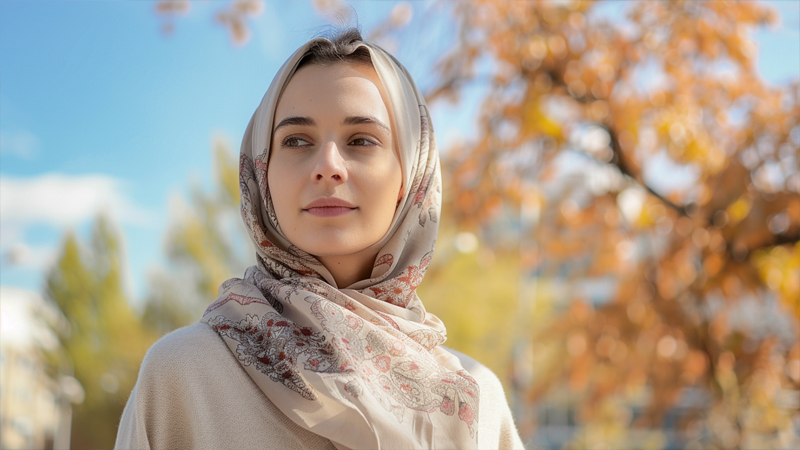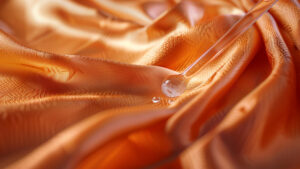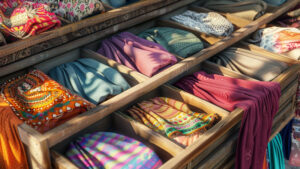
I love how handmade cotton headscarves blend practicality with a personal, artisanal touch.
Handmade cotton headscarves combine style, comfort, and tradition. They feature unique designs, support local artisans, and are easy to care for.
Let’s explore their amazing variety.
What unique designs are found in handmade cotton scarves?
Handmade cotton scarves often feature hand-dyed colors1 and intricate patterns2.
These creations showcase playful prints, traditional motifs, and creative stitching that stand apart from mass-produced items.

I still remember stumbling upon a tiny market stall overflowing with handmade cotton scarves. Each one felt like a new discovery, with patterns ranging from soft floral borders to bold, abstract shapes. The fact that they were all hand-dyed or embellished gave them a certain magic—almost as though every scarf carried a personal story. Some wore subtle brushstrokes of color, while others proudly displayed swirling lines or geometric shapes that hinted at cultural heritage.
Celebrating Art and Individuality
A big part of the charm lies in the slight variations you’ll find from one piece to another. No two scarves are exactly alike, which makes them feel extra special. I’ve even come across scarves stamped with tiny, symbolic designs unique to a specific region. Whenever I drape one over my shoulders, it’s as if I’m wearing a small piece of someone’s creative spirit. That emotional bond goes far beyond just a piece of fabric—it’s a conversation starter, a friendly wave to the artisan who crafted it.
At the same time, these designs can be surprisingly versatile. I might tie a colorful scarf around my head when I’m in a playful mood, or I’ll use a more subdued pattern as a subtle statement at work. Because the cotton is usually breathable, I can wear these scarves during warm summer days without feeling stuffy. If there’s a chill in the air, I’ll layer a cardigan on top, allowing the scarf’s pattern to peek through. In a world where everything moves fast and mass-produced items flood the market, handmade cotton scarves feel like a calming, soulful alternative. They remind me that slow and steady craftsmanship can still shine bright in modern times.
What are the benefits of choosing handmade accessories?
Handmade items offer a personal touch and reduce mass-production waste.
They are often eco-friendly3, reflect human creativity, and carry a lasting sense of authenticity4.

I once gifted a handmade cotton scarf to a dear friend who appreciates unique finds. She later told me how special it felt to own something created by an individual’s hands, not just by a machine. That sense of personalization is hard to describe, but it adds a little spark to everyday life. Handmade accessories also tend to be produced in smaller batches, lowering their environmental impact compared to large-scale factory operations.
A Deeper Sense of Value
I’ve noticed that when I spend money on a handmade scarf, I feel more connected to my purchase. There’s a story woven into each fiber—perhaps the artisan spent hours picking just the right shade of dye, or carefully stitched a motif passed down through generations. That intimacy, that slow, deliberate process, is what stands out. Instead of a mass-produced item with no real character, I get something that shows thoughtful craftsmanship.
Handmade pieces can also be surprisingly durable. Artisans usually pay close attention to details, ensuring seams are tight and materials are high quality. This means your scarf may last far longer than a cheaper, factory-made version. You’ll also discover small brand labels where the maker signs their work or includes a brief note about the design’s inspiration. It feels like a reminder of the real human effort that went into creating this accessory. That kind of connection goes beyond mere fashion—it becomes a quiet celebration of human artistry.
How does purchasing handmade products support artisans?
Your purchase helps local crafters earn a fair wage and keeps traditional skills alive.
Buying handmade allows artisans to grow their businesses, preserve cultural techniques, and pass on creativity to future generations.

I remember chatting with a craftswoman who specialized in hand-loomed cotton5. She spoke about how each sale helped her buy quality materials and support her family. Whenever I wear one of her scarves, I think of her dedicated hands and the pride she takes in her work. This direct link makes me feel like I’m part of a bigger story—one that values community and keeps cultural techniques from fading away.
Building Communities and Honoring Heritage
Many artisans rely on local weaving or dyeing traditions6 that have been passed down for decades. Each time we purchase a handmade headscarf, we help sustain those practices. It’s not just about making a living for a single crafter; it’s about uplifting an entire network of people who share a passion for art. These small businesses, cooperatives, or family-run workshops often reinvest in training younger generations, ensuring their skills don’t disappear in a world dominated by mass production.
In places with limited job opportunities, artisan work can be a lifeline. It provides a flexible, creative outlet while supporting local economies. I’ve seen projects where female artisans band together, pooling resources to buy raw materials or open a tiny storefront in a local market. One sale at a time, they can invest in better tools, expand their collections, and perhaps even hire apprentices. So, when we choose a handmade cotton scarf, we’re not just getting an accessory—we’re championing the talent and future of an entire community.
What are the care tips for maintaining cotton headscarves?
Gently hand-wash in mild detergent, and air-dry to preserve shape and color.
Proper care protects the fabric’s softness, ensuring your cotton headscarf stays vibrant for years.

I’ve learned the hard way that even the sturdiest cotton scarf can lose its charm if tossed into a harsh wash cycle. After accidentally shrinking a favorite piece, I switched to hand-washing with lukewarm water7. Now, I use a gentle detergent8—something formulated for delicate fabrics—and rinse thoroughly to prevent soap residue from dulling the colors. If I’m in a rush, I might use the gentle cycle on my machine, but I’ll enclose the scarf in a mesh laundry bag just to be safe.
Preserving Color and Texture
Once washed, I resist the urge to wring out the excess water. Instead, I gently press the scarf between two towels and lay it flat to air-dry. This approach prevents stretching or misshaping the weave. Cotton can be fairly forgiving, but constant tugging or high-heat drying can break down fibers over time.
If you’re someone who loves crisp folds, you can lightly iron your scarf on a low setting. However, I usually skip that step unless I’m wearing the scarf to a special occasion. A few wrinkles can add character—after all, it’s handmade. Storing your scarves correctly also helps. I fold them neatly and place them in a drawer or on a shelf where they won’t be crumpled. Some friends hang them on a scarf rack, making sure they’re in a cool, dry spot. The trick is to avoid direct sunlight or damp areas that can cause fading or mildew. With a little mindful care, these headscarves can stay part of your wardrobe for years, continuing to share their gentle charm every time you wear them.
Conclusion
Handmade cotton headscarves bring style and soul, linking us to artisans and the beauty of personalized craftsmanship.
-
Discover the intricate process behind hand-dyed colors, revealing the artistry and skill involved in creating unique textile designs. ↩
-
Learn about the various techniques artisans use to craft intricate patterns, highlighting the creativity and cultural significance behind each design. ↩
-
Exploring this link will reveal how handmade items contribute to environmental sustainability, offering insights into eco-conscious living. ↩
-
This link will delve into the unique qualities of handmade items that imbue them with authenticity, enhancing your appreciation for artisanal craftsmanship. ↩
-
Exploring the benefits of hand-loomed cotton can reveal its unique qualities and the positive impact on artisans and the environment. ↩
-
Understanding the impact of local weaving or dyeing traditions can highlight their role in cultural preservation and community development. ↩
-
Discover the benefits of hand-washing with lukewarm water to maintain the integrity and longevity of delicate fabrics. ↩
-
Learn about the top gentle detergents that protect delicate fabrics from damage and preserve their color and texture. ↩




